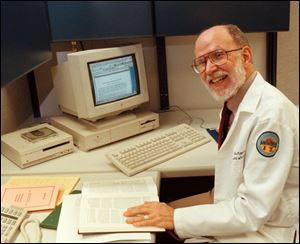
Disaster triggers 1st use of emergency response team
9/17/2001
Saul: The ex-Toledoan runs a U.S. medical response unit.
WASHINGTON - The terrorists didn't follow the script.
From federal disaster workers to shocked tourists outside an evacuated White House, that was an initial reaction - after shock and disbelief - to Tuesday's attacks.
“It's striking to think that we've been preparing for unconventional terrorist attacks,” said Dr. Frank P. Saul, director of a National Disaster Medical System emergency response team.
“We've visualized attacks with weapons of mass destruction, chemical and biological agents,” he added. “What gets us? WMDs? CBAs? No. Low-tech assaults. People crashing commercial jetliners into buildings.”
Sean Collins, a college student from Vancouver, Canada, hoping to tour the White House with a group of friends, expressed similar sentiments.
“It took awfully sophisticated planning. You can be sure of that,” Mr. Collins said the day of the attack, listening to news on a portable radio at police lines two blocks away from a White House surrounded by Secret Service agents armed with automatic weapons.
“But the method was simple, almost simplistic. We were worried about - oh, weird things like cyberterrorism. You know, sabotaging the Internet, crashing the communications system and financial markets, and bringing the world to its knees that way. They played it simple.”
Dr. Saul, an internationally known forensic scientist from Toledo, directs a regional emergency medical response team that is part of the National Disaster Medical System. The system was organized by the U.S. Department of Health and Human Services to deal with terrorist acts and other disasters. He is a former dean at the Medical College of Ohio.
Health and Human Services Secretary Tommy G. Thompson activated the National Disaster Medical System Tuesday, preparing medical teams nationwide to assist officials in New York City, Washington, and possibly the airliner crash site near Somerset, Pa. It was the first time the medical system has been activated nationwide.
The National Disaster Medical System is a partnership of federal agencies, including the Federal Emergency Management Agency, the Department of Defense, and the private sector. The system provides direct medical care, patient evacuation, and nonfederal hospital care.
About 7,000 private-sector medical and support personnel also work on the 80 disaster assistance teams.
The teams are deployed when local emergency-response systems become overwhelmed. They provide immediate medical attention to the sick and injured during disasters, as well as mortuary and veterinary care.
Medical system teams have assisted with natural disasters, including a major deployment to Houston after Tropical Storm Allison this year.
In addition, other units of the Disaster Medical System were activated under the order, including Disaster Mortuary Operational Response Teams, burn units, and the International Medical Surgical Emergency Response Team, located in Boston.
The National Disaster Medical System's sponsors are among more than 40 federal departments, agencies, and bureaus that have some role in combating terrorism.
U.S. policy on combating domestic terrorism has heavily emphasized high-tech attacks since a 1995 revision by former President Bill Clinton, a 1997 General Accounting Office report said.
The policy had three goals: Reduce vulnerabilities and prevent terrorist acts before they occur; manage the consequences of terrorist attacks; and punish terrorist perpetrators.
Weapons of mass destruction and chemical-biological weapon attacks were a central consideration in each goal. The high-tech terrorist-attack mentality also permeated federal agencies.
“We're facing the possibility of an electronic Pearl Harbor,” then-deputy secretary of defense John Harme told a congressional hearing in 1997. “There is going to be an electronic attack on this country sometime in the future.”
Training of emergency personnel also emphasized esoteric threats. One secret Pentagon drill in the late 1990s trained personnel on dealing with terrorist attacks on computer databases and communications systems.